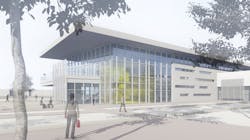DOE Launches $75 Million Grid Energy Storage Research Facility
The U.S. Department of Energy (DOE) recently announced the beginning of design and construction of the Grid Storage Launchpad (GSL), a US$75 million facility located at Pacific Northwest National Laboratory (PNNL) in Richland, Washington. The GSL will boost clean energy adaptation and accelerate the development and deployment of long-duration, low-cost grid energy storage.
The planned facility will include 30 research laboratories, some of which will be testing chambers capable of assessing prototypes and new grid energy storage technologies under real-world grid operating conditions. The GSL will include flexible workstations and collaboration spaces, including Fellowship Labs, which will provide dedicated space for researchers to incubate storage technologies originating from the U.S. research and development community.
"The GSL facility will bring together researchers and industry from around the country to modernize and add flexibility to the power grid, advance storage technologies, and boost use of clean energy," said Secretary of Energy Jennifer M. Granholm. "Deploying new grid technologies means we can get more renewable power on the system, support a growing fleet of electric vehicles (EVs), make our grid more reliable and resilient, and secure our clean energy future."
The GSL will focus on three outcomes to advance grid energy storage development:
- Collaboration: Bringing the DOE, multidisciplinary researchers, and industry together at the facility will lower the barriers to innovation and deployment of grid-scale energy storage.
- Validation: The facility will enable independent testing of next-generation grid energy storage materials and systems under realistic grid operating conditions.
- Acceleration: From benchtop to systems, the facility will de-risk and speed the development of new technologies by propagating rigorous performance requirements.
During this new phase of development, the PNNL will select a design and construction contractor and begin working toward the start of construction, which could begin late this year. The building is expected to be operational and ready for occupancy by 2025.
"It took 40 years to get to the current state of today's lithium-ion battery technology, but we need to move much faster to develop the long-duration, low-cost batteries needed to meet the significant challenges of decarbonizing the energy system," said PNNL Director Steven Ashby. "The GSL will speed up the process considerably by doing the work needed to develop and deploy new grid storage technologies."
"Accelerating the development of energy storage technologies is fundamental to the transition to a cleaner and more diverse electricity grid," said Senator Maria Cantwell. "By manufacturing and deploying these technologies here at home we will reduce energy costs, create jobs, and help keep the lights on during extreme weather emergencies."
In addition to federal funding, the Washington State Department of Commerce has committed US$8.3 million for advanced research equipment and specialized instrumentation that will provide significant insights into the behavior of battery materials during operation.
The state's Department of Commerce has also signed a memorandum of understanding (MOU) with the DOE's Office of Electricity to promote partnerships to advance grid energy storage technologies, support the energy storage innovation ecosystem, and share best practices with other states. This collaboration builds upon a previous MOU signed in 2016 that focused on grid modernization, as well as ongoing work with the PNNL through the 2019 Grid Modernization Lab Call.
The GSL also supports the DOE's Energy Storage Grand Challenge, which draws on the extensive research capabilities of the DOE National Laboratories, universities, and industry to accelerate the development of energy storage technologies and sustain American global leadership in the energy storage technologies of the future and a secure domestic manufacturing supply chain.
